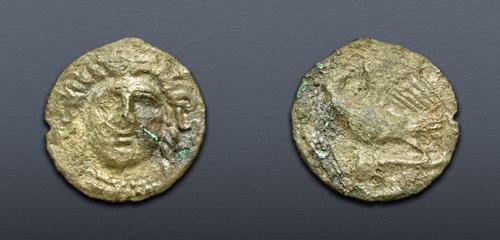|
SKYTHIA, Olbia. Circa 350-330 BC. Cast Æ (63.5mm, 74.43 g, 12h). Wreathed head of Demeter facing / Sea eagle standing left, wings spread and head right, on dolphin left. Anokhin 233; Karyshkovskij p. 399, Таб. VI=B, 1–2; Frolova & Abramzon 231–4; HGC 4, 1882. Rough olive green patina, some spots of encrustation. Fine. Very rare.
From the Skillman Collection. Ex .
These are the final cast bronze coins of Olbia during the Classical Period, as well as the final large cast bronze asses in Olbia's history. There are 8 different varieties known, distinguished by the letters and/or symbol on their reverse. Letters A, B, Γ, and E are known without other symbols, while Δ is found with a star, and Y with an ear of grain. An ear of grain also occurs without a letter, and some examples have no letters or symbols at all. The appearance of these letters and symbols may reflect a change in the political structure of the city. In numismatics, the appearance of letters on pre-Hellenistic coinage have often been connected with oligarchy (see, for instance, coins of Samos [Barron, pp. 40-3, 89-93] and Tauric Chersonesos [Anokhin, Khersonesa, pp. 44-45]). Thus, an oligarchic system may have been reinstated at Olbia circa 350 BC. In 334 BC, Alexander the Great changed the ruling oligarchy in Miletos, the parent city of Olbia, and a desire to change the political situation in Olbia may have prompted Alexander's general Zopyrion to besiege the city in circa 330 BC.
Closing Date and Time: 17 July 2024 at 10:12:40 ET.
All winning bids are subject to a 20% buyer’s fee.
|
